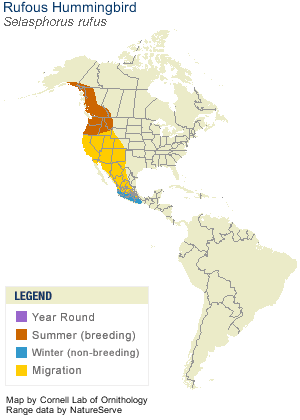Hummingbirds in the Pacific Northwest
Endemic to the Americas, there are at least 330 species of hummingbirds across the Northern and Southern Hemispheres, with 17 species in United States and Canada. Within the geography of Pacific Birds, we have several resident or seasonal migrant species, including the Calliope Hummingbird, the smallest of our species weighing in at 2-3 grams! More common within the Pacific Birds region- depending on the latitude and local habitats- are the Rufous, Anna’s and Allen's Hummingbirds. Alaska hosts only a few species and Hawaii has none.
Some of these little powerhouses make astonishing migratory flights that researchers and managers are only beginning to understand. While a few species overwinter in our area, most are migrating to the southern U.S., Mexico and Central America. Banding studies on Rufous Hummingbirds show a fascinating story. As one example, an individual banded in Florida in 2010 traveled at least 3500 miles before it was recaptured in Chenega Bay, Alaska! The Alaska Hummingbird Project has banded or recaptured individuals migrating between Chenega Bay and Florida, Colorado, Texas, and California.
Regional Partnerships
In 2009, the U.S. Forest Service and the Hummingbird Monitoring Network (HMN) hosted an international workshop in Arizona to share information about hummingbird research, monitoring and habitat. While hummingbirds have been monitored through programs such as the Breeding Bird Survey, the HMN and other efforts, there had not been a broad, international effort to coordinate hummingbird conservation in the Western U.S., Canada and Mexico. Some species were known or suspected to be in decline, however. Building from prior and ongoing efforts, and a desire to address research needs and conservation concerns, the Western Hummingbird Partnership (WHP) solidified after that 2009 workshop and today includes a broad coalition of partners across North America.
Conservation, Climate Change and Concerns
One goal of the WHP is to promote effective stewardship and management, based on what we know to date about hummingbirds. Partners such as the U.S. Forest Service are working to educate homeowners, land managers and others about both the resource needs and values of these great pollinators. One example is Maintaining and Improving Habitat for Hummingbirds in Oregon and Washington – A Land Manager’s Guide, which provides information about common species and the nectar plants that they depend upon. And the benefits are going in both directions- while the hummingbirds need the nectar resources, people are relying on hummingbirds for pollinating plants that we use for food, landscaping and aesthetics.
In our northern reaches, the U.S. Forest Service has also been putting a concerted effort into learning more about the Rufous and Anna’s Hummingbirds that occur in Southeast Alaska. Gwen Baluss, a USFS wildlife technician on the Juneau Ranger District, has been leading a hummingbird monitoring effort since 2013. Gwen, with partners and many volunteers, is conducting surveys and making foraging observations, as well as banding hummingbirds at two Juneau locations and contributing to molecular biology studies. Among many interesting questions about hummingbirds, researchers are interested in where the birds travel- both for migration and for local foraging. The Forest Service interest in hummingbirds is understandable, since the majority of hummingbird species are dependent upon forested habitats. According to Cheryl Carrothers, Regional Wildlife Program Leader for the Forest Service in Alaska, “Understanding the resource needs of hummingbirds is essential to their conservation, and a fundamental part of our Forest Service mission 'to sustain the health, diversity, and productivity of the Nation’s forests and grasslands to meet the needs of present and future generations.' ”
Researchers are also learning more about population trends and threats to hummingbirds, and that knowledge will help focus conservation priorities. Declines of up to 3% a year have been noted for the Rufous Hummingbird, and hummingbirds are starting to get more notice as species to watch. One large question mark is how climate change will affect populations. With generally warming trends in the Pacific Northwest, species appear to be expanding their ranges, overwintering more and perhaps shifting migration patterns. Changes in the timing of food availability will certainly have an influence on where hummingbirds are found in the future. Hummingbirds will also be under some of the same threats as other landbirds, such as habitat alteration and invasive species. Research being conducted by Environment Canada is examining trends in Rufous Hummingbird populations in North America relative to climate and habitat change, weather patterns, and range extensions in species such as Anna’s Hummingbirds. Collaborative studies among Environment Canada, Simon Fraser and Royal Roads University in British Columbia, are examining the effects of agro-ecosystems and pesticide exposure on Rufous Hummingbird occurrence.
As spring and summer arrive throughout our region, partners watching out for hummingbirds will be busy observing, banding and otherwise learning more about the movements and habits of species. The projects in this story, and others such as the National Audubon Society’s Hummingbirds at Home citizen science initiative, may provide additional opportunities to get involved and help the effort to conserve our smallest birds.
Where are hummingbirds now? Check them out on e-bird.

